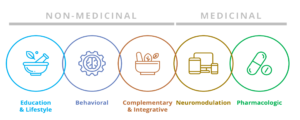Carl Cincinnato
The new year is a common time to reflect over the past year and think about the next one. As you contemplate the year ahead, consider a New Year Resolution that might help improve your migraine condition.
Many people with migraine think that your health and wellbeing is solely in the hands of your doctor. We know that is not true.
Self-management is an essential part of effective chronic disease management. Yes, your doctor is important but you play the central role in your health care. Many people underestimate the impact they can have on their own condition.
An individual’s knowledge, behavior, lifestyle, and diet are all significant factors in multiple chronic illnesses including migraine.
A New Year Resolution might feel like a luxury when you have chronic pain. It isn’t. It may be even more important to have a purpose-driven goal to help you move away from a life of chronic pain or illness.
Why have a New Year Resolution?
Having a New Year Resolution is like setting a goal. Setting a goal gives you a long-term vision and short-term motivation. It focuses your acquisition of knowledge and helps you organize your time and resources to achieve results.
Top athletes, successful business people, and achievers in all fields set goals.
How to set a New Year’s Resolution that sticks
According to Harvard health, your goal should be “SMART” which stands for Specific, Measurable, Attainable, Relevant, and Time-bound. The SMART approach ensures you’ve defined your goals clearly and can attain them.
Specific: Goals need to be clear and detailed. Vague goals can feel overwhelming. Instead of saying “I want to get rid of my migraine attacks” consider “I want to drink 5 glasses of water per day” or “I want to walk 20 mins each day.”
Measurable: If you have no way to measure a goal, it’s tough to know when you’ve met it. “I’m going to reduce my migraine attacks” is a goal that becomes more effective with a measurable outcome, such as “I want less than 15 days of migraine each month by April this year.”
Attainable: Avoid overly grand goals. They should be based on what you realistically can do. “If you used to be able to walk five miles without fatigue and now can only do a mile, lower your expectations with a goal of walking three miles without fatigue.”
Relevant: Is your goal important to your life right now? You do not want to set goals just to have a goal. It needs to have a purpose, or you may find it harder to stick with.
Time-bound: Is your goal something that you can take on right now — or is it best for later? Also, is the time frame you have chosen suitable? You probably will not be able to halve your migraine frequency in a few weeks so be generous and give yourself sufficient time.
Tips and watchouts
Expect obstacles: Many times, we talk ourselves out of goals because of obstacles or the idea that goals must be achieved in a certain way. When challenges and doubts arise, change your approach. Goal setting can also be a journey of self-discovery where new options, knowledge, and alternatives present themselves.
Start small: Reducing days with migraine can feel overwhelming if you’ve been trying to do this unsuccessfully in the past. Break down your goal into small steps so you can celebrate success along the way. For example, you could start by educating yourself about factors can lead to chronic migraine or discovering what you can do yourself to help reduce migraine frequency (Hint: See Dr. David Dodick’s interview on Controlling Unresponsive Chronic Migraine). Decide to better understand the treatment options available. (Hint: See our Treatment Directory for those with the VIP pass). Improve your sleep habits with guidance from Dr. Christine Lay. Or search for a new doctor or headache specialist in your area.
Reward yourself: positive feedback is a reward in itself. Treat yourself to a massage, dinner or something to acknowledge the progress you have made.
Monitor your progress: keep a migraine diary, join a support group online, find a supporter to encourage you or ask a friend or family member to check in with you regularly.
Be kinder to yourself: Remember this is about progress, not perfection. Expect to get knocked down by migraine at times this year. Don’t be too harsh on yourself when it happens. Try to be prepared, give yourself time to recover, utilize the help of others and celebrate any progress you make.
Migraine can be miserable, exhausting and frustrating. Many general doctors need better understanding and we need better support. These things are changing slowly. In the meantime, you can make progress by taking small steps in the right direction.
Happy New Year and Best Wishes for 2020.
Posted in: Migraine Education





